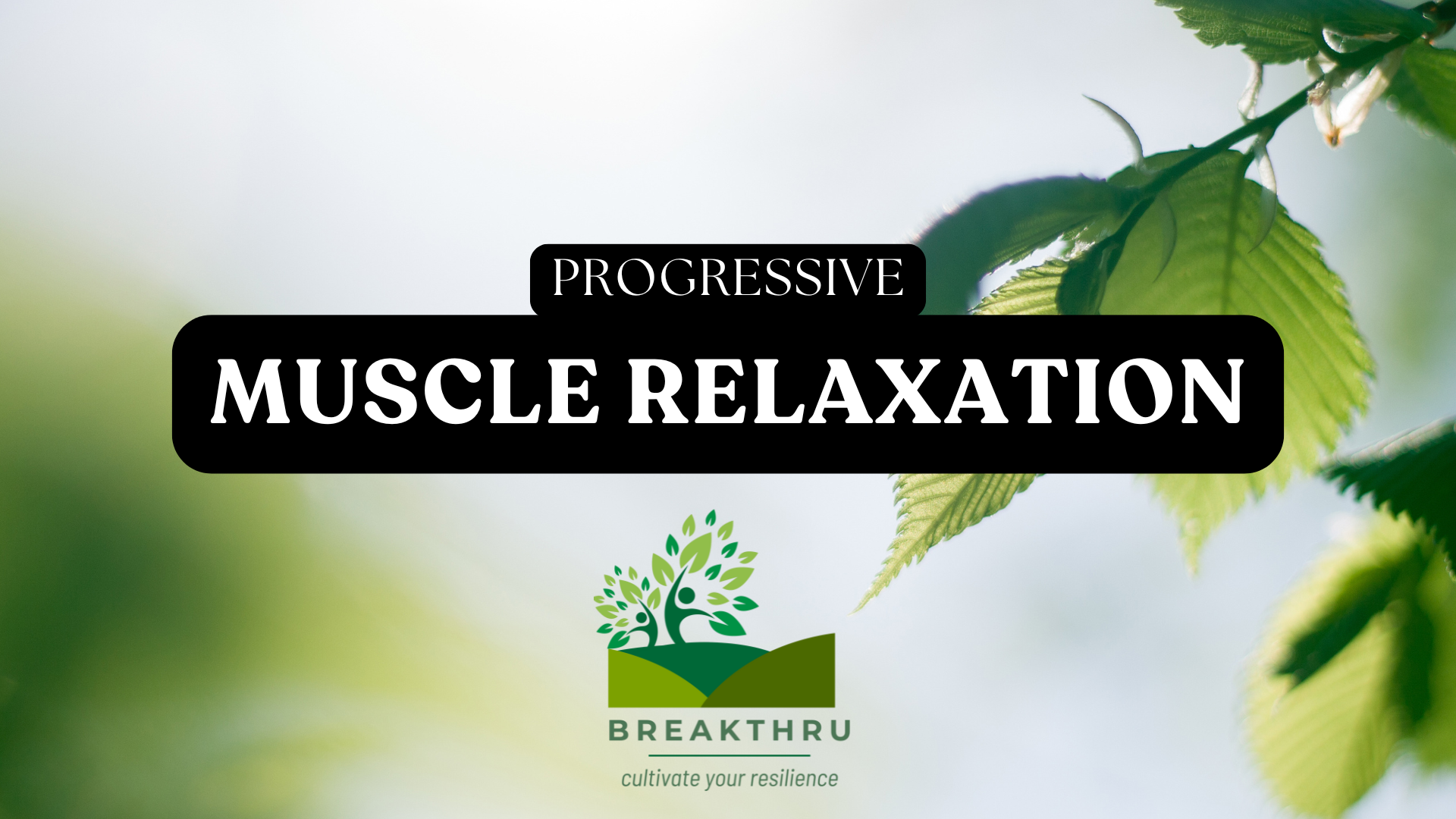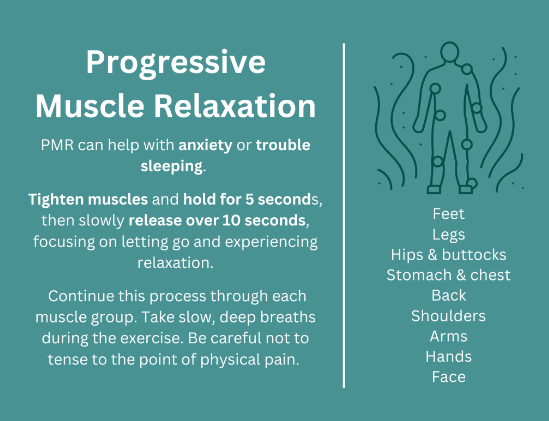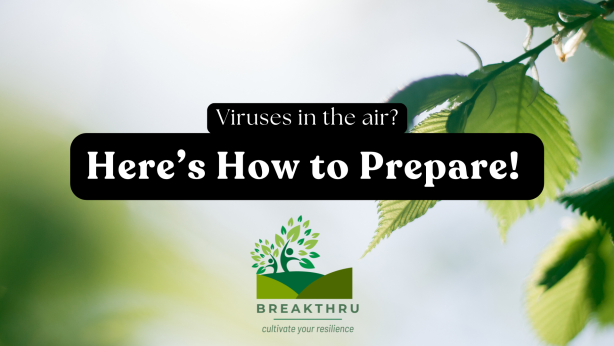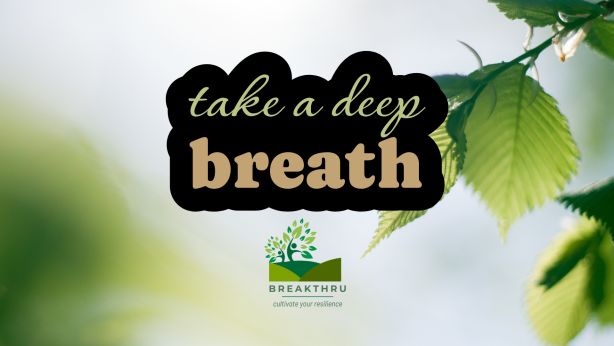Understanding Progressive Muscle Relaxation

Understanding Progressive Muscle Relaxation (PMR) is a simple, yet effective technique designed to help you release tension from your body. The method involves systematically tensing and relaxing different muscle groups, allowing you to focus on the sensation of relaxation as the tension melts away.
PMR is particularly useful in reducing anxiety, making it a valuable tool for managing stress in various settings, including academics, where it can help alleviate test anxiety. It’s also beneficial for those struggling with insomnia. While guided videos or audio resources can be helpful when you are first learning PMR, once mastered, you can practice it anytime, anywhere.
PMR helps interrupt the cycle of anxiety that connects your mind and body. When anxious thoughts arise, they can activate your body’s stress response, causing your muscles to tense up as part of the fight-or-flight reaction. This physical tension can then reinforce anxious thoughts, creating a feedback loop. By consciously relaxing your muscles, you can calm your mind. With regular practice, PMR can also help you become more aware of early signs of tension and anxiety, enabling you to manage them before they intensify.
Ready to practice?
Ready to practice? Follow the written instructions below or use one of the videos to get started with PMR.
Find a comfortable position and take slow, deep breaths throughout the exercise. Begin by gently tensing each muscle group, being careful not to overdo it to the point of pain. As you release the tension, pay close attention to the contrast between the sensations of tightness and relaxation. This awareness is key to mastering the technique.
- Feet: Curl your toes to tighten the muscles in your feet. Hold for 5 seconds. Slowly release over 10 seconds, focusing on the feeling of relaxation.
- Legs: Tighten your leg muscles. Hold for 5 seconds. Slowly release over 10 seconds, letting go of tension and feeling the relaxation.
- Hips and Buttocks: Squeeze the muscles in your hips and buttocks. Hold for 5 seconds. Slowly release over 10 seconds, focusing on relaxation.
- Stomach and Chest: Tighten your stomach and chest muscles by pulling in your stomach and holding your breath. Hold for 5 seconds. Slowly release over 10 seconds, experiencing the relaxation.
- Back: Arch your back slightly and squeeze your shoulder blades together. Hold for 5 seconds. Slowly release over 10 seconds, letting go of tension.
- Shoulders: Lift your shoulders towards your ears. Hold for 5 seconds. Slowly release over 10 seconds, lowering your shoulders and relaxing.
- Upper Arms: Bend your elbows to tighten your upper arm muscles. Hold for 5 seconds. Slowly release over 10 seconds, focusing on relaxation.
- Forearms: Bend your wrists back to tighten your forearm muscles. Hold for 5 seconds. Slowly release over 10 seconds, letting go of tension.
- Hands: Make a fist to tighten your hand muscles. Hold for 5 seconds. Slowly release over 10 seconds, experiencing relaxation.
- Face: Squeeze your eyes shut and scrunch your forehead. Hold for 5 seconds. Slowly release over 10 seconds, focusing on the sensation of relaxation.

Interested in joining BreakTHRU? CLICK HERE
References
Hubbard, K. K., & Blyler, D. (2016). Improving academic performance and working memory in health science graduate students using progressive muscle relaxation training. American Journal of Occupational Therapy, 70, 7006230010. http://dx.doi.org/10.5014/ajot.2016.020644
Ignite Healthwise, LLC. (2023, June 24). Progressive muscle relaxation. Kaiser Permanente. https://healthy.kaiserpermanente.org/health-wellness/health-encyclopedia/he.progressive-muscle-relaxation.ta4146
Lichstein, K. L., Taylor, D. J., McCrae, C. S., & Thomas, S. J. (2011). Relaxation for insomnia. BSM Treatment Protocols for Insomnia (pp. 45-54). Elsevier Inc. DOI: 10.1016/B978-0-12-381522-4.00004-3
Mirgain, S. A., & Singles, J. (2024, May 1). Progressive muscle relaxation. U.S. Department of Veterans Affairs. https://www.va.gov/WHOLEHEALTHLIBRARY/tools/progressive-muscle-relaxation.asp
Sutton, J. (2020, July 8). Progressive muscle relaxation: 10 scripts for effective PMR. Positive Psychology. https://positivepsychology.com/progressive-muscle-relaxation-pmr/#benefits
Toussaint, L., Nguyen, Q. A., Roettger, C., Dixon, K., Offenbacher, M., Kohs, N., Hirsch, J., & Sirois, F. (2021). Effectiveness of progressive muscle relaxation, deep breathing, and guided imagery in promoting psychological and physiological states of relaxation. Evidence-based complementary and alternative medicine : eCAM, 2021, 5924040. https://doi.org/10.1155/2021/5924040



